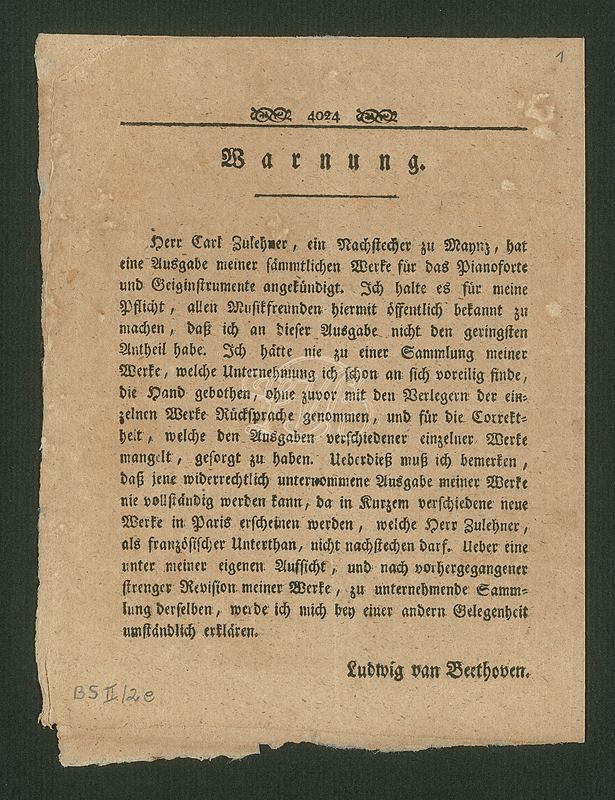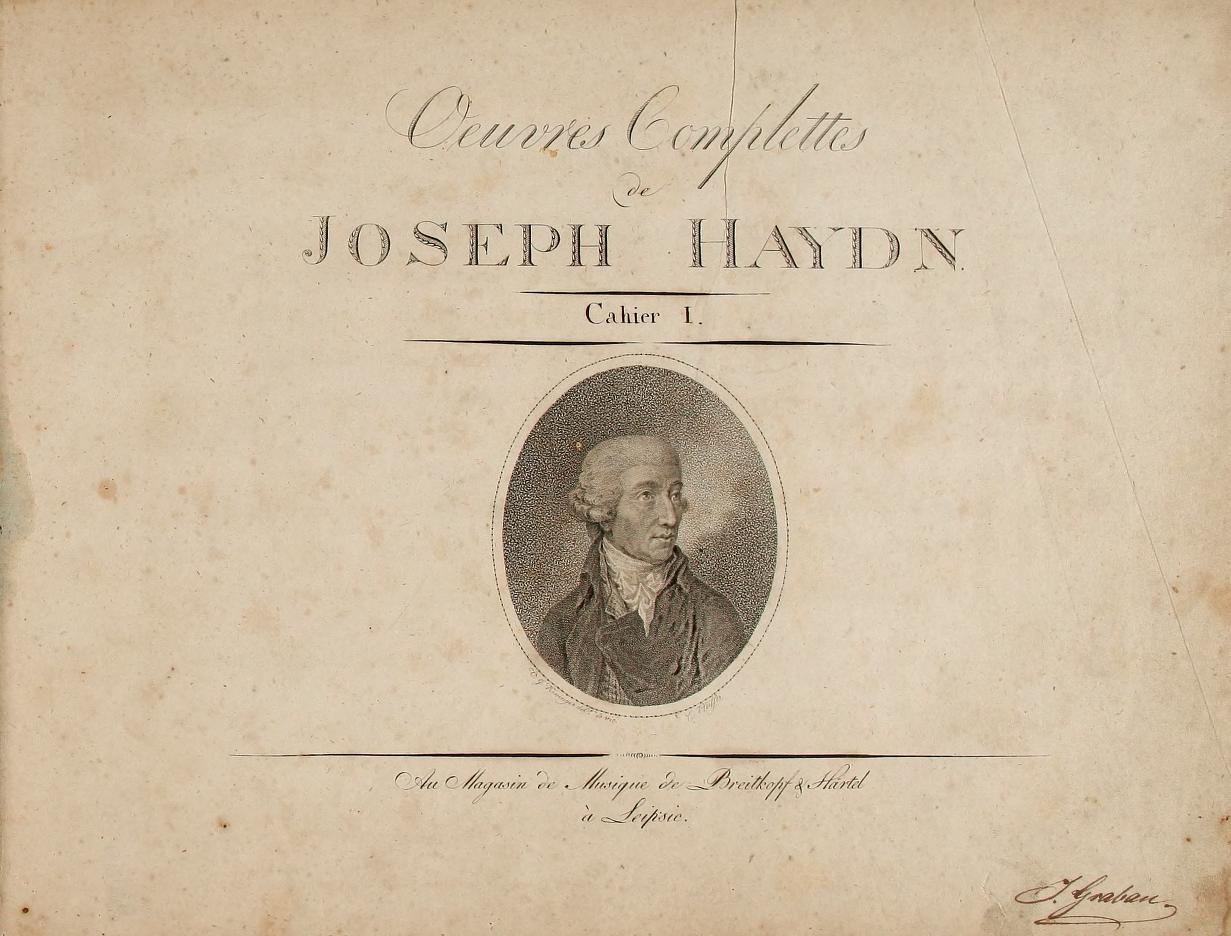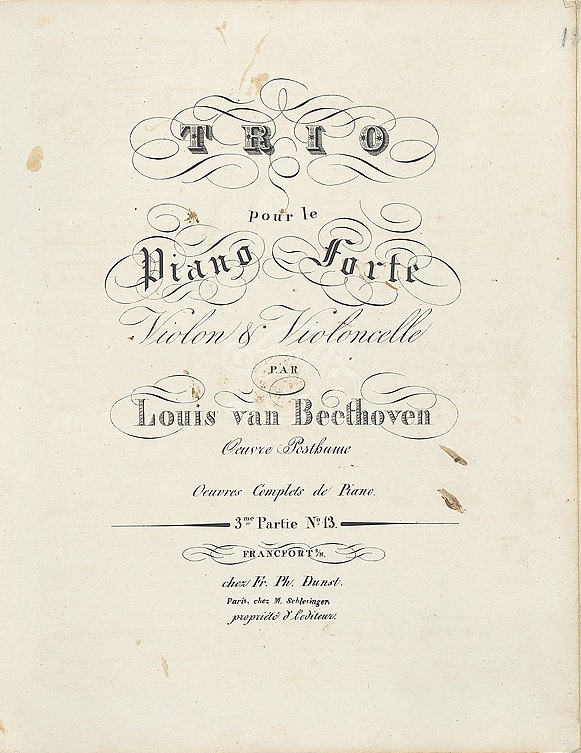
With kind permission by the Beethoven-Haus Bonn
Only what we have as whole, do we truly have – that, of course, also applies to Beethoven, so it’s hardly surprising that there are an astonishing number of hits in the Beethoven year when googling “Beethoven Complete”. Searching by key terms such as “Complete Works” or “Complete Edition” quickly teaches us, however, that today Beethoven is more likely to be heard than read or played. Coming up as first hits long before Henle’s well-known scholarly complete edition are large concerto cycles or huge CD productions covering his entire oeuvre – and with Beethoven going viral over the entire world. That’s natural today – and in a time of coronavirus it is at least an opportunity to deal with “Beethoven Complete” despite closed museums, concert halls and opera houses. But what was it like before? And since when has there been this interest in “Beethoven Complete”?
The perhaps surprising answer is: as early as Beethoven’s lifetime. After all, the fact that we view the legacies of a great artist as a whole work and commemorate it after his death may indeed still be viable. But that the creator himself pursued this idea shows first of all a fair degree of self-confidence, though it also reflects a certain zeitgeist. The idea of a classical artwork outlasting time became popular in the age of the classics. Authors such as Christoph Martin Wieland or Johann Wolfgang von Goethe felt compelled to publish correct editions of all their works. This led in music at the end of the 18th century to the emergence of series called Oeuvres Complettes, in which publishing houses, from small firms like Spehr’s “Magasin de musique” in Braunschweig or C. F. Lehmann in Leipzig, to giants like Breitkopf & Härtel, above all, acknowledged the piano and chamber-music works of such well-known and successful composers as Mozart, Haydn or Clementi.
No wonder that in his desire for “a collected edition of my works” in August 1810, Beethoven also first turned to Breitkopf – whereupon the publisher made it clear to him that this project was hardly realistic. Not least because, on the one hand, many of his compositions had already been printed by so many and various publishers that legal problems existed, and on the other, because large sales were not to be expected. This was the target of the really “cheap” Breitkopf series of Oeuvres Complettes.
For these reasons Beethoven’s further attempts to have a complete edition of his works published by Simrock, Peters, Haslinger or Schott remained unsuccessful – though this does not mean that there was no complete Beethoven edition during the composer’s lifetime! For other publishers were less scrupulous, for example, the versatile musician and entrepreneur Carl Zulehner in Mainz. Between 1802 and 1809 he had already succeeded in “realising the idea of a complete Beethoven edition in a respectable approach thanks to the safe exploitation of the territorial conditions of his time as the first publisher” – as Kurt Dorfmüller, grand seigneur of Beethoven publishing research, so beautifully worded it.

Wiener Zeitung, 1803. With kind permission by the Beethoven-Haus Bonn.
That means, plainly: In his Collection complette des oeuvres de musique pour le piano forte composées par Louis van Beethoven, Zulehner simply reprinted the composer’s works that had already appeared in far-off Vienna, Leipzig or London, without concerning himself about Beethoven’s consent or taking into account the original publishers’ rights! Beethoven was, accordingly, “not amused” and published explicit “warnings” in the Vienna and Leipzig press in the autumn of 1803 about this “copycat engraver in Maynz”.
Zulehner’s edition did not of course offer “Beethoven Complete”: Since, as was customary at the time with Oeuvres Complettes, it was limited to piano and chamber music, together with lieder accompanied by piano, and since no previously unprinted works were included. And “lacking”, of course, were ultimately the future works of this composer who was at his creative zenith in 1809.
As is hardly otherwise to be expected, after Beethoven’s death in 1827, numerous publishers came on the market with “complete editions” of the most various sorts: whether “Beethoven’s symphonies”, arranged by Carl Czerny as piano duets for domestic consumption (published by Probst in Leipzig) or arranged by Johann Nepomuk Hummel for piano quartet (published by Chappel & Co in London), or Haslinger’s large-scale undertaking of “All the Works by Ludw. Van Beethoven”, announced in December 1828 as available by subscription. That edition, to be organised in 12 sections from piano music to chamber music, with and without piano, to solo concertos (in score) and symphonies (in parts), did not de facto get beyond 66 works in nine sections, but was definitely the attempt coming closest to our present idea of a complete edition. Since Haslinger included only works in his edition whose rights he either owned or was given by other publishers, he was doomed to fail: of the concertos only Op. 15 was published in full score, the symphonies were discontinued after three editions (Opp. 36, 55 and 60).
The single successful, systematic project of a complete edition at that time could only be realised by a more unscrupulous publisher: In his Collection Complète des Oeuvres pour le Pianoforte […] composées par Louis van Beethoven, published from 1829, Franz Philipp Dunst, who seems only to have given the original publisher rights little consideration, managed within a few years to produce a complete edition of the piano and piano chamber music as well as a “Complete Collection of all the Songs with Piano Accompaniment” in 4 sections and 127 single volumes. With this edition he delivered for the first time the “Beethoven Complete” that could be realised at home on and around the piano. Included were first editions such as the piano trios WoO 38 and 39, whose authenticity and origin Dunst explained on a specially inserted leaf and had signed by Anton Diabelli, Carl Czerny and Ferdinand Ries.
Beethoven, title pages of the first edition of WoO 38
With kind permission by the Beethoven-Haus Bonn
So, by the way, Dunst also introduced another not insignificant innovation in chamber music works: the piano part as a full score, which considerably facilitates making music together and also allows the work to be read. It is nice that this type of presentation has prevailed over the long term – so that even today, despite currently limited cultural offers and opportunities for making music together, we can at least enjoy “Beethoven Complete” by reaching into the music cabinet.



